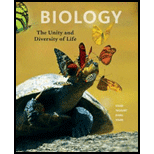
Concept explainers
A heterozygous individual has a _______ for a trait being studied.
- a. pair of identical alleles
- b. pair of nonidentical alleles
- c. haploid condition, in genetic terms
Concept introduction: The pair of chromosomes where one of the pairs is of the maternal source and the other is of the paternal source that has genes in the same loci with variable alleles of the gene is called homologous chromosomes. The allele is the modification of the gene. The alleles are of two types, namely dominant and recessive.
Answer to Problem 1SQ
Correct answer: A heterozygous individual has a pair of nonidentical alleles for a trait being studied. Therefore, option b. is correct.
Explanation of Solution
Reasons for the correct statement:
Homozygous individuals have the same alleles on the gene loci either dominant homozygous or recessive homozygous. Heterozygous individuals have one dominant allele and one recessive allele. Thus, two different types of alleles of the same gene are present in the gene loci that are not identical to each other.
Option b. is given as “a pair of nonidentical alleles”
As heterozygous individuals possess different alleles of the same gene for the trait expressed, option b. is correct.
Reasons for the incorrect statements:
Option a. is given as “a pair of identical alleles”.
Homozygous individuals only have the same allele on both homologous chromosomes that is, the pair of identical alleles. Therefore, option a. is incorrect.
Option c. is given as “haploid condition, in genetic terms”.
Haploid condition refers to half the number of chromosomes. A heterozygous individual has two sets of chromosomes. Therefore, option c. is incorrect.
Hence, options a. and c. are incorrect.
Want to see more full solutions like this?
Chapter 13 Solutions
Biology: The Unity and Diversity of Life (MindTap Course List)
- Other than oil and alcohol, are there other liquids you could compare to water (that are liquid at room temperature)? How is water unique compared to these other liquids? What follow-up experiment would you like to do, and how would you relate it to your life?arrow_forwardSelection of Traits What adaptations do scavengers have for locating and feeding on prey? What adaptations do predators have for capturing and consuming prey?arrow_forwardCompetition Between Species What natural processes limit populations from growing too large? What are some resources organisms can compete over in their natural habitat?arrow_forward
- Species Interactions Explain how predators, prey and scavengers interact. Explain whether predators and scavengers are necessary or beneficial for an ecosystem.arrow_forwardmagine that you are conducting research on fruit type and seed dispersal. You submitted a paper to a peer-reviewed journal that addresses the factors that impact fruit type and seed dispersal mechanisms in plants of Central America. The editor of the journal communicates that your paper may be published if you make ‘minor revisions’ to the document. Describe two characteristics that you would expect in seeds that are dispersed by the wind. Contrast this with what you would expect for seeds that are gathered, buried or eaten by animals, and explain why they are different. (Editor’s note: Providing this information in your discussion will help readers to consider the significance of the research).arrow_forwardWhat is the difference between Uniporters, Symporters and Antiporters? Which of these are examples of active transport?arrow_forward
- What are Amyloid Fibrils? What biological functions are these known to perform?arrow_forwardHow do histamine and prostaglandins help in the mobilization of leukocytes to an injury site? What are chemotactic factors? How do they affect inflammation process?arrow_forwardCompare and contrast neutrophils and macrophages. Describe two ways they are different and two ways they are similar.arrow_forward
 Biology Today and Tomorrow without Physiology (Mi...BiologyISBN:9781305117396Author:Cecie Starr, Christine Evers, Lisa StarrPublisher:Cengage Learning
Biology Today and Tomorrow without Physiology (Mi...BiologyISBN:9781305117396Author:Cecie Starr, Christine Evers, Lisa StarrPublisher:Cengage Learning
 Biology (MindTap Course List)BiologyISBN:9781337392938Author:Eldra Solomon, Charles Martin, Diana W. Martin, Linda R. BergPublisher:Cengage Learning
Biology (MindTap Course List)BiologyISBN:9781337392938Author:Eldra Solomon, Charles Martin, Diana W. Martin, Linda R. BergPublisher:Cengage Learning Human Heredity: Principles and Issues (MindTap Co...BiologyISBN:9781305251052Author:Michael CummingsPublisher:Cengage Learning
Human Heredity: Principles and Issues (MindTap Co...BiologyISBN:9781305251052Author:Michael CummingsPublisher:Cengage Learning Human Biology (MindTap Course List)BiologyISBN:9781305112100Author:Cecie Starr, Beverly McMillanPublisher:Cengage Learning
Human Biology (MindTap Course List)BiologyISBN:9781305112100Author:Cecie Starr, Beverly McMillanPublisher:Cengage Learning Concepts of BiologyBiologyISBN:9781938168116Author:Samantha Fowler, Rebecca Roush, James WisePublisher:OpenStax College
Concepts of BiologyBiologyISBN:9781938168116Author:Samantha Fowler, Rebecca Roush, James WisePublisher:OpenStax College





